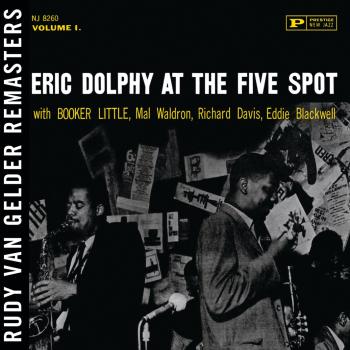
Out To Lunch Eric Dolphy
Album Info
Album Veröffentlichung:
1964
HRA-Veröffentlichung:
18.04.2014
Das Album enthält Albumcover Booklet (PDF)
Entschuldigen Sie bitte!
Sehr geehrter HIGHRESAUDIO Besucher,
leider kann das Album zurzeit aufgrund von Länder- und Lizenzbeschränkungen nicht gekauft werden oder uns liegt der offizielle Veröffentlichungstermin für Ihr Land noch nicht vor. Wir aktualisieren unsere Veröffentlichungstermine ein- bis zweimal die Woche. Bitte schauen Sie ab und zu mal wieder rein.
Wir empfehlen Ihnen das Album auf Ihre Merkliste zu setzen.
Wir bedanken uns für Ihr Verständnis und Ihre Geduld.
Ihr, HIGHRESAUDIO
- 1 Hat And Beard 08:24
- 2 Something Sweet, Something Tender 06:02
- 3 Gazzelloni 07:17
- 4 Out To Lunch 12:06
- 5 Straight Up And Down 08:19
Info zu Out To Lunch
Before leaving the U.S. for Europe and his premature date with destiny, reedman/composer Eric Dolphy collaborated with Blue Note auteur Alfred Lion in early 1964 to produce his finest, most forward-looking recording.
Having already stretched the bebop vocabulary beyond its breaking point as a sideman and leader, Dolphy finally zeroed in on his ideal vision of freedom and form with „Out To Lunch“, creating a style of group interplay that remains unique more than 30 years later. That's because in vibraphonist Bobby Hutcherson, bassist Richard Davis and 19-year-old drummer Tony Williams, Dolphy encountered a dauntless, intuitive rhythm section that could delineate time without stating it, while providing a harmonic backdrop that was expressive and free. On the odd metric figurations of the title tune, the rhythm section constantly reacts and regroups around Dolphy's fulminating, vocalized alto lines. Occasionally they come together to swing in the traditional sense of ensemble interplay--as they do on Freddie Hubbard's bumble bee trumpet solo--but more often than not they abstract the pulse in bold cubist slivers of color and wide expanses of silence.
Thelonious Monk's influence is keenly felt in Dolphy's playful writing, especially on 'Hat and Beard' and 'Straight Up And Down.' The latter employs a bold comical theme whose wide intervallic leaps and stammering rhythm accents portray the sauntering gait of a drunk. The former is a nod to the letter and spirit of Monk, and Dolphy's bass clarinet playing is fervent, forceful and hilariously human. Finally, 'Something Sweet, Something Tender' and 'Gazzellioni' focus on the more ruminative side of Dolphy's art, first in tandem with Davis' expressive arco playing, then in a dancing, exhilirating flute feature--the most swinging ensemble work of the date. „Out To Lunch“ is an innovative document by one of the most emotional, resourceful reedmen in jazz history.
'Surreal sonics -- Davis' undulating notes aren't just heard but felt....A freewheeling trip.' (Down Beat)
Eric Dolphy, alto saxophone, flute, bass clarinet
Freddie Hubbard, trumpet
Bobby Hutcherson, vibraphone
Richard Davis, bass
Tony Williams, drums
Recorded at the Van Gelder Studio, Englewood Cliffs, New Jersey on February 25, 1964
Produced by Alfred Lion
Digitally remastered
Eric Dolphy
was a true original with his own distinctive styles on alto, flute, and bass clarinet. His music fell into the "avant-garde" category yet he did not discard chordal improvisation altogether (although the relationship of his notes to the chords was often pretty abstract). While most of the other "free jazz" players sounded very serious in their playing, Dolphy's solos often came across as ecstatic and exuberant. His improvisations utilized very wide intervals, a variety of nonmusical speechlike sounds, and its own logic. Although the alto was his main axe, Dolphy was the first flutist to move beyond bop (influencing James Newton) and he largely introduced the bass clarinet to jazz as a solo instrument. He was also one of the first (after Coleman Hawkins) to record unaccompanied horn solos, preceding Anthony Braxton by five years.
Eric Dolphy first recorded while with Roy Porter & His Orchestra (1948-1950) in Los Angeles, he was in the Army for two years, and he then played in obscurity in L.A. until he joined the Chico Hamilton Quintet in 1958. In 1959 he settled in New York and was soon a member of the Charles Mingus Quartet. By 1960 Dolphy was recording regularly as a leader for Prestige and gaining attention for his work with Mingus, but throughout his short career he had difficulty gaining steady work due to his very advanced style. Dolphy recorded quite a bit during 1960-1961, including three albums cut at the Five Spot while with trumpeter Booker Little, Free Jazz with Ornette Coleman, sessions with Max Roach, and some European dates.
Late in 1961 Dolphy was part of the John Coltrane Quintet; their engagement at the Village Vanguard caused conservative critics to try to smear them as playing "anti-jazz" due to the lengthy and very free solos. During 1962-1963 Dolphy played third stream music with Gunther Schuller and Orchestra U.S.A., and gigged all too rarely with his own group. In 1964 he recorded his classic Out to Lunch for Blue Note and traveled to Europe with the Charles Mingus Sextet (which was arguably the bassist's most exciting band, as shown on The Great Concert of Charles Mingus). After he chose to stay in Europe, Dolphy had a few gigs but then died suddenly from a diabetic coma at the age of 36, a major loss.
Virtually all of Eric Dolphy's recordings are in print, including a nine-CD box set of all of his Prestige sessions. In addition, Dolphy can be seen on film with John Coltrane (included on The Coltrane Legacy) and with Mingus from 1964 on a video released by Shanachie. (Scott Yanow)
Booklet für Out To Lunch













